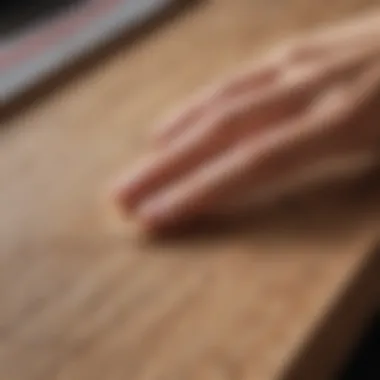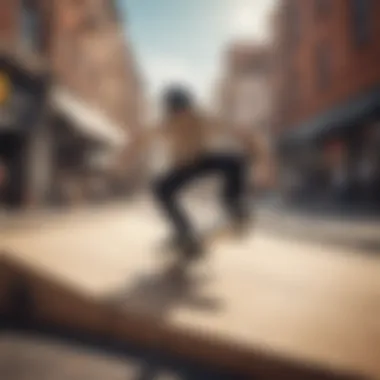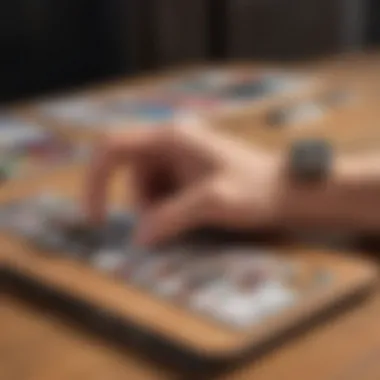The Ultimate Guide to Finger Boards and Their Features


Intro
Finger boarding may appear as a small niche within the vast landscape of skateboarding, yet it carries with it a rich culture and significant depth. With its roots tracing back to the late 20th century, finger boarding has transitioned from being a playful pastime to a recognized sport and art form. For enthusiasts, this engaging mini-skateboarding experience embodies not just tricks and stunts but a lifestyle brimming with creativity.
In this guide, we aim to explore the elements that enrich the world of finger boarding. We will delve into key features that characterize quality finger boards, chart the evolution of this sport over the years, and investigate its role in the broader skateboarding culture. Readers can expect insights on choosing the right model that best fits their style, reviews of top finger boards currently available in the market, and advice on maintenance and customization. By the end, one should have a well-rounded understanding of finger boarding and its intricate charms.
Tricks and Techniques
Finger boarding is not merely about gliding along the tabletop or performing the odd trick; it's a form of expression that encourages creativity and skill development. As you embark on your finger boarding journey, mastering specific tricks is not just essential, but can be quite rewarding.
Mastering the Heelflip
One of the standout tricks in finger boarding is the heelflip. Unlike its cousin, the kickflip, where the board spins under your fingers as you flick, the heelflip requires a different touch. To set yourself up:
- Position your fingers correctly; your index should be near the tail, while the middle finger is set just behind the front wheels.
- Flick with your heel instead of your toe, giving the board a good spin.
The key here is to ensure a balance between speed and accuracy. A slow flick may lead to an incomplete spin, while too fast can throw off your landing.
Tips for Consistent Landings
Achieving consistent landings is a game-changer for finger boarders. Here are some practical tips to help you perfect that art of landing:
- Practice, Practice, Practice: There’s no shortcut. Keep at it, and don't get discouraged by falls.
- Focus on Foot Placement: Be cognizant of where your fingers land once the trick is executed. The right placement can greatly affect balance.
- Visualize the Trick: Before attempting, take a moment to visualize the movements in your mind. This mental practice can make a world of difference.
"Consistency in landing comes with patience and practice. Don’t rush the process."
With these techniques, you will surely find yourself gaining confidence and improving your finger boarding skills substantially.
Skate Gear and Equipment
Choosing the right finger board and gear is crucial for optimizing your performance. Quality can make a significant difference in how well you can execute tricks.
Choosing the Right Fingerboard
When selecting a fingerboard, consider the following features:
- Material: Look for boards made of durable materials like wood or high-quality plastic.
- Wheels: Check for softer wheels that can provide grip yet allow smooth motion.
- Size: Different styles suit different hands. Try out various sizes to find out what feels best.
Essential Maintenance Tips
Like any piece of equipment, finger boards require maintenance to ensure peak performance:
- Regular Cleaning: Dust and debris can hinder your board’s effectiveness. A quick wipe goes a long way.
- Wheel Tightness: Ensure your wheels aren’t too loose or too tight. The right tension helps in fluid movements.
- Customization Options: Consider customizing your board for both aesthetic appeal and improved performance. Stickers, new wheels, or a unique grip tape can do wonders.
Understanding these aspects allows finger boarders to not only perform better but also take pride in their gear.
Prologue to Finger Board Culture
Finger boarding has evolved from a simple toy into a dynamic culture intertwined deeply with the skateboarding world. While it may seem like just a pastime for those who have smaller fingers, its significance runs much deeper. This section uncovers the roots and growth of finger boarding while highlighting its relevance and impact on skateboarding enthusiasts and the broader community.
Origins and Evolution
The journey of finger boarding dates back to the 1970s in California, where skateboarders needed a way to practice tricks when they weren't on their boards. These early innovators fashioned mini skateboards from scraps, using simple materials, much like the DIY spirit that defines the skateboard movement at large. It was not until the 1990s that finger boards became commercially available, with companies like Tech Deck stepping onto the scene, turning these handmade versions into a popular product.
The evolution of finger boards since then has been notable. From the early wooden models to the colorful, high-performance options that exist today, manufacturers have continuously adapted and improved designs based on feedback from users. Simple tricks have also transformed into complex routines that echo the extraordinary creativity of full-sized skateboarding tricks. With this shift, finger boarding has gained its own dedicated following, much like the skateboarding community itself.
Cultural Significance in Skateboarding
Finger boarding embodies more than just a child’s plaything; it serves as an essential tool for learning and sharing skills within the skateboarding culture. Because of its portable nature, finger boards allow enthusiasts to practice anywhere, leading to spontaneous community gatherings—often at parks or skate shops—where individuals can showcase their skills or learn new techniques from others.
"Finger boarding is not just a hobby. It's a way to connect with friends, practice my skills, and show off my creativity," says Jason, a longtime finger board enthusiast.
Moreover, many skateboarders who engage with finger boarding often report that it helps refine their hand-eye coordination, allowing them to translate skills between their finger boards and full-sized skateboards. Additionally, it brings an artistic flair to skating, fostering creativity through theme-based board designs and tricks.
Through online platforms like forums or social media groups, finger boarding enthusiasts frequently share tips, techniques, and videos. The influence of digital culture on finger boarding can’t be understated. It has democratized access to tutorials and tricks, making it possible for anyone, anywhere, to dive into this intricate art, ultimately solidifying its standing as a sister culture to skateboarding.
As we proceed through this guide, we will further explore the fundamentals of finger boarding, from understanding what finger boards are to learning the tricks that can elevate your skills. By appreciating the rich history and culture behind finger boarding, readers can deepen their connection to the art form and uncover the joy it holds in the skateboarding community.
Fundamentals of Finger Boarding
Understanding the fundamentals of finger boarding is crucial for anyone entering this captivating realm. It lays the groundwork for both newcomers and seasoned enthusiasts, helping them navigate through the nuances of this miniature skateboarding world. A firm grasp of the basics not only enhances performance but also deepens appreciation for the craft itself. As with any specialized hobby, starting with the right knowledge can make the journey enjoyable and fruitful.
What is a Finger Board?
A finger board is essentially a miniature version of a skateboard, designed for dexterous users to perform tricks and maneuvers using their fingers. Unlike traditional skateboards that rely on feet and body weight, finger boards are operated solely by finger movements, allowing for intricate control over the board. They usually come in a variety of designs, sizes, and materials, which affects how they perform and feel during use.


The beauty of finger boards lies not just in their physical characteristics, but in the way they mimic the full-scale skateboarding experience. Similar to how a skateboard utilizes a deck, trucks, and wheels, a finger board incorporates these elements, enabling a similar feel and responsiveness. You may encounter them made from wood, plastic, or composites, each impacting how it rides and performs. When you hold one, it feels familiar yet distinct, inviting you to try an array of tricks that require skill and precision.
In the finger boarding community, there's a shared understanding that the choice of equipment can greatly influence performance, making it essential for aficionados to select boards thoughtfully. Whether you're trying out a basic ollie or contemplating foot-high kickflips, knowing what a finger board is sets the stage for your journey.
Basic Techniques and Tricks
Finger boarding is as much about finesse as it is about technique. Initiating practice with basic techniques can pave the way for mastering advanced tricks. Here’s a rundown of some fundamental techniques every finger boarder should become familiar with:
- Ollie: This is a foundational trick, where you pop the tail of the board using your ring and middle fingers to create vertical lift.
- Pop Shove-It: This trick combines the ollie with a spin. As you ollie, your fingers will also guide the board to rotate 180 degrees beneath you.
- Kickflip: A well-loved maneuver where you flick the edge of the board with your middle finger while popping—bringing it to flip in mid-air.
- Grinds: Involve balancing the board on an edge surface such as a ledge or rail. It’s all about timing your balance as you ride over obstacles.
Each trick requires practice and patience, but that’s part of the charm of finger boarding. As you hone your skills, you’ll find that combining tricks leads to even more creative possibilities. Not only does finger boarding improve fine motor skills, but it also nurtures a sense of community and belonging as you engage with others sharing the same passion.
Key Features of Quality Finger Boards
When diving into the realm of fingerboarding, it's imperative to understand that not all finger boards are created equal. The factors that make one board superior to another can profoundly influence the user experience, regardless of whether you’re a seasoned fingerboarding pro or a newbie just finding your footing. Key features play a significant role in determining the board’s overall performance, handling, and aesthetic appeal. Here, we will dissect these crucial aspects, guiding you through what to look for when selecting the best fingerboard that suits your needs.
Material Composition
When considering finger boards, the material composition cannot be overlooked. This encompasses the materials used to construct the deck, which can drastically affect durability and performance.
Wood
Wooden fingerboards are often hailed for their authentic feel. The characteristic of wood is its natural grip and responsiveness, which many riders find satisfying. The key characteristic of wood is its strength combined with flexibility, which offers a balance that can enhance tricks. Additionally, the unique feature of wood is its ability to mimic the feel of a real skateboard. However, they can be prone to chipping and, over time, may need replacement.
Plastic
Plastic fingerboards provide a different experience, often more durable and less susceptible to wear and tear than wood. This makes them a popular choice for beginners who may be less gentle with their boards. The key characteristic of plastic is its lightweight nature, which allows for easier maneuverability and control. A unique feature of plastic boards is the variety of colors and designs available. However, they might lack the grip and engaging feel that wood boards offer.
Composites
Composites offer an intriguing blend of materials, combining the best characteristics of wood and plastic. They often feature a core of wood surrounded by a layer of a synthetic material, leading to enhanced durability. The key characteristic of composites is their versatility—offering a feel akin to wood while providing the resilience of plastic. The unique feature lies in their ability to maintain flex for tricks while being resistant to common damages. Nonetheless, they can sometimes come at a higher price point, which might not suit every wallet.
Design Considerations
After material, design plays a pivotal role in how well a finger board performs. This encompasses various elements, including the board's shape, grip, and overall artwork.
Shape
The shape of a finger board isn’t just about looks; it significantly affects performance. Most boards have variations such as the popsicle shape, which is ideal for tricks, or the cruiser shape, favored for stability. The key characteristic of shape is how it influences maneuverability. An interesting element in the shape discussion is the concave feature, which helps grip during tricks. For beginners, choosing the right shape can enhance confidence and performance.
Grip
Grip tape is another critical factor in fingerboarding. A high-quality grip will provide the necessary traction, allowing for precision during tricks. The key characteristic of grip is its texture and adhesion—it needs to keep your fingers secure without wearing down too quickly. A distinct advantage of good grip is that it can elevate a rider’s confidence in executing complex maneuvers. However, it might require occasional replacement, which is a minor trade-off for the enhanced performance it brings.
Artwork
The visual appeal of a finger board shouldn’t be underestimated. Custom artwork can reflect a rider's personality, making sessions more enjoyable. The key characteristic of artwork is its ability to allow expression; each board can tell a different story. Not only does appealing art enhance aesthetics, but it also can affect the emotional connection a rider feels with their board. That said, while some riders prioritize visuals, many will argue that performance should take precedence.
Wheel Performance
When riding, the wheels are your point of contact with the surface and affect how tricks will be executed.
Hardness
Wheel hardness is rated on a durometer scale, with softer wheels providing more grip and harder wheels enabling faster speeds. The key characteristic of hardness comes into play in various environments—hard wheels may excel on smooth surfaces, while softer wheels perform better on rougher terrain. An intriguing detail about wheel hardness is the way it can influence trick execution and comfort level during rides. While soft wheels can be easier to handle, they may wear down faster.
Diameter
The diameter of wheels also plays a role in performance. Smaller wheels are generally better for technical tricks, while larger ones can provide more speed and stability. The key characteristic of diameter is its relationship to the overall board experience—larger wheels tend to elevate the board higher off the ground, improving balance. An interesting point to consider is how varying diameters can shift the entire feel of fingerboarding, influencing how one approaches tricks.
Material
Lastly, the material of wheels influences their longevity and performance. Common materials include urethane, which is often chosen for its blend of durability and grip. The key characteristic of material impacts ride feel significantly. Urethane wheels offer an edge in silent rides and smooth roll-over obstacles. The only downside is that they can be pricier than simpler materials, but many find the extra cost justified due to enhanced performance.
How to Choose the Right Finger Board
Selecting the right finger board is a crucial step in ensuring that your experience is enjoyable and fulfilling. Just like traditional skateboards, finger boarding has a plethora of options, each tailored for different styles and skill levels. This section aims to help you navigate the choices you face when looking for a finger board, focusing on two primary aspects: assessing your skill level and identifying your personal preferences.
Skill Level Assessment
Before you start browsing through various finger boards, it's essential to understand your skill level. This assessment will guide you toward a board that complements your current abilities and encourages growth without frustration.
- Beginner: If you’re just starting, look for boards that provide stability and ease of use. A wider deck can help balance better and minimize falls. Often, these boards will have softer wheels to ensure a comfortable ride on various surfaces.
- Intermediate: At this stage, you may be ready to experiment with more complicated tricks. Intermediate boards tend to be a bit lighter and responsive, which can enhance trick execution. You might want to opt for a deck that has some concave to support your foot placement.
- Advanced: Experienced finger boarders might favor boards that are highly specialized. Here, materials play a key role—think about a harder wood for finer control or well-crafted wheels that ensure speed and agility.
Assessing where you stand will help you avoid the pitfall of purchasing a board that's above your skill level, which can lead to discouragement.


"Choosing a finger board that suits your ability not only enhances the fun but also boosts your confidence."
Purpose and Personal Preference
Knowing what you want from finger boarding can significantly influence your choice. Do you aim to perform tricks? Or is it more about casual riding and showcasing your style? Identifying your objectives can lead to a successful selection.
- Trick Performance: If your goal is to pull off stunts like flips or grinds, you should lean towards boards designed for maneuverability. Small wheel diameter and a nimble deck can make pivots and spins easier.
- Casual Use: For relaxed riding or just showing off your creativity, it might be wise to focus on aesthetics—selecting boards with unique designs or customizable options can make your experience more personal.
- Collectibility: some enthusiasts are drawn to unique or limited-edition boards. If this describes you, consider not just the functionality but also the backstory of the board.
Personal preferences also extend to the artwork and theme of the board. Some riders revel in the artistic aspect and take pride in boards that reflect their personal styles.
Overall, experimenting with different styles can lead to a deeper appreciation for the craft of finger boarding, paving the way for richer experiences. By meticulously assessing your skills and expressing your unique purpose, you’ll discover the right board that aligns perfectly with your journey.
Top Finger Boards on the Market
Evaluating the top finger boards available today is crucial for anyone aiming to enhance their fingerboarding journey. This section highlights certain models and their significant features, benefits, and various considerations for each one. Knowing what's on the market helps enthusiasts, both novice and expert, to make informed decisions that best suit their preferences and needs.
High-End Options
When it comes to finger boards, high-end models often stand out due to their superior materials and craftsmanship. Brands like Blackriver and FlatFace offer products that are crafted to perfection, appealing to serious fingerboarders who desire quality and performance. These fingerboards typically use multilayer wood constructions, ensuring durability and responsiveness.
Among the benefits of high-end options are:
- Precision performance: These boards often feature better wheel bearings and truck design, allowing for smoother tricks and maneuvers.
- Unique designs: Often, these boards showcase intricate artwork or custom shapes, making them highly collectible.
- Enhanced grip: High-end wheels usually provide superior traction, allowing for more reliable tricks.
Budget-Friendly Choices
For those not looking to break the bank, budget-friendly finger boards are available that don’t compromise too much on quality. Brands like Tech Deck and SkateGo cater to this market, offering more affordable options that are ideal for beginners or casual riders.
Some crucial aspects to consider:
- Adequate performance: While not offering the same level as high-end models, many budget boards still deliver a decent experience, making them suitable for skill development.
- Durable material: Although they may use less premium materials, many budget boards are built to last through regular use.
- Variety: Budget-friendly options often include various designs, colors, and collaborations, which can be appealing for younger audiences or casual users.
When choosing a budget option, it’s important to balance cost with performance to ensure a satisfying experience.
Collaborations and Limited Editions
The world of fingerboarding is tighter than you might think, often connecting artists and fingerboard brands through collaborations and limited editions. Notably, brands like SML Wheels frequently release special models that celebrate various themes or partnerships.
Highlights of these collaborations often include:
- Unique aesthetics: Limited editions usually feature exclusive artwork that stands out from regular models, making them collectibles.
- Community involvement: Collaborative models often reflect themes from pop culture or support specific social causes, resonating with the target audience.
- Enhanced value: Owning a limited edition can be seen as a badge of honor within the fingerboarding community, adding an extra layer of appeal.
In essence, collaborating with artists and influencers allows brands to capture the imagination of enthusiasts, motivating them to purchase these unique offerings.
"Buying a limited edition means getting a piece of the culture, while also having something that might increase in value over time.”
Maintenance and Care for Finger Boards
Maintaining and caring for your finger board is not just a matter of prolonging its life; it’s a pathway to ensuring optimal performance and enhancing your overall experience. Finger boards, while compact and often overlooked, are prone to wear and tear just like their full-sized counterparts. Regular maintenance can prevent minor issues from escalating into significant problems, ensuring that your tiny skateboarding experience remains smooth and enjoyable.
Key aspects to consider include keeping the board clean, checking the hardware for wear, and ensuring the wheels spin freely. Moreover, understanding the need for maintenance allows enthusiasts to develop a deeper connection with their tool and inspires creativity in customization. When a board is well-maintained, it can glide smoothly, respond accurately to your tricks, and look sharp while doing it, combining aesthetics with functionality.
Regular Maintenance Practices
Taking care of your finger board doesn’t have to be a daunting task. Here are some practical steps that you can incorporate into your routine:
- Routine Cleaning: Dust and debris can accumulate in a blink, affecting performance. To clean your finger board, gently wipe the surface with a damp cloth. For stubborn grime, a mild soap solution can work wonders. Be careful not to saturate any part of your board, especially the grip tape.
- Wheel Check: Regularly inspect the wheels for dirt and grime. If you notice slowing movement, they might need a thorough cleaning. You can detach them and soak them in warm soapy water, followed by scrubbing with a soft brush. Dry completely before reattaching.
- Loose Screws: Occasionally, you may find that the hardware is not as tight as it should be. A simple check with a mini screwdriver can help tighten any loose screws, which is crucial for stability while performing tricks.
- Grip Tape Replacement: If you notice that the grip has lost its texture or is showing signs of wear, it's time to replace it. This simple practice can drastically improve your control and riding experience.
By integrating these maintenance habits into your routine, you can prolong the life of your finger board significantly and ensure its performance stays top-notch.
Common Repairs and Upgrades
Despite the best efforts, even the most diligent caretakers may face some wear and tear or damage. Here are some of the most common repairs and options for upgrades that can breathe new life into your setup:
- Replacing the Grip Tape: If your grip tape is past its prime, peeling it off and putting on a fresh layer can not only give your board new life but also allows for personalization with different designs and textures.
- Wheel Replacement: As wheels wear down, they can create a less smooth and effective ride. Opting for higher-quality wheels can greatly enhance your performance. You can choose different hardnesses based on your style of finger boarding—softer wheels grip better, while harder wheels are faster.
- Adding Bushings: Upgrading the bushings can help improve the steering and responsiveness of your finger board. This enhancement can play a significant role especially if your tricks require precise movements.
- Deck Customization: A cracked or damaged deck doesn’t have to mean the end of your board. You can always replace your deck with a new design of your choice that better reflects your personality and style. This is also a great way to experiment with different shapes and sizes.
"Caring for your fingerboard not only gives it longevity, it also allows your creativity to flourish as you customize and upgrade it over time."
Customization Opportunities
In the diverse world of finger boarding, customization holds a special place. Many enthusiasts view it not merely as an option but as an essential part of personal expression. A well-customized finger board allows skaters to convey their style, preferences, and individuality. This section dives into two primary aspects of customization: decals and artwork, alongside performance tuning.
Decals and Artwork
Adding decals and artwork to a finger board transforms it from a standard piece into a unique masterpiece. This customization step isn’t just about aesthetics; it creates a personal connection to the board. Here’s why investing time in this area matters:


- Identity Expression: Using markers, stickers, or custom graphics, riders tailor their boards to represent their personality. Whether it's an abstract design or a tribute to a favorite skate brand, the choice is deeply personal.
- Creative Outlet: For some, artwork is a way to unleash creativity. Painting or drawing on the board becomes a fun activity, allowing one to explore artistic skills.
- Community Connection: Sharing deck designs within finger boarding communities, either on platforms like Reddit or Instagram, fosters camaraderie. When others appreciate a design or even ask for tips, it strengthens social bonds.
Furthermore, the type of materials used for decals can significantly affect longevity. Opt for high-quality vinyl stickers or waterproof paint to ensure the artwork withstands frequent use.
Tuning Performance
Customization doesn't end with looks. Tuning the performance of a finger board is equally important, directly impacting tricks and maneuvers. Such adjustments enhance the overall riding experience. Here are crucial aspects to consider in tuning:
- Wheel Hardness: Soft wheels offer better grip, suited for tricks requiring stability, while harder wheels slide better. Choosing the right hardness aligns with the tricks you plan to land.
- Bearing Quality: Upgrading to high-performance bearings allows for smoother rolls. Not only does this enhance speed, but it also extends the lifespan of the board.
- Deck Flexibility: Some riders prefer a stiffer deck while others enjoy the springiness. Testing different setups helps find the right balance of flexibility to achieve desired performance during tricks.
A well-tuned board not only performs better but also boosts the rider's confidence in executing complex tricks.
To sum it up, balancing customization aesthetics with performance tuning creates a finger board that's as unique as its rider. Embracing these opportunities allows for an enriching finger boarding journey whether at a local park or during competitions.
The Intersection of Finger Boarding and Traditional Skateboarding
The relationship between finger boarding and traditional skateboarding is far from coincidental. As the popularity of finger boards surged, it created a bridge between those who thrive on full-sized skateboards and those who prefer the dexterity of their tiny counterparts. This section delves into how the skills developed in finger boarding can enhance performance on a traditional skateboard, and vice versa. Understanding this connection can enrich the experience for both practitioners.
Skill Transferability
When you are maneuvering a finger board, you are not just flicking it around with your fingers. You are actually honing a set of skills that are remarkably similar to those required for riding a skateboard. For instance, performing a trick like a kickflip or an ollie on a finger board involves the same body mechanics and timing as executing these tricks on a full-sized skateboard.
- The perception of balance, foot positioning, and timing are crucial in both realms.
- When transitioning from finger boards to skateboards, practitioners often find they can apply the same principles learned with their smaller counterparts. This skill transfer is a boon for novice skaters aspiring to develop their skills in a less intimidating environment, allowing them to practice tricks without the risk of falls.
Moreover, finger boarding provides a practial platform for visualizing trick combinations. Practitioners can take their finger board anywhere, squeezing in practice in short bursts that might be impossible with a large skateboard. This portability facilitates an understanding of how to sequence tricks together, giving a would-be skateboarder the opportunity to experiment and experiment before hitting the pavement.
Crossover Events and Competitions
As finger boarding gained traction, various communities began to organize crossover events that showcased the harmony between the two sports. These events not only foster unity among enthusiasts but also highlight the fluidity of skills across both disciplines.
At competitions, participants often engage in both finger boarding and traditional skateboarding, showcasing their versatility while competing for trophies or prizes.
- Some of the most prominent competitions, like World of Fingerboarding, feature categories that bridge the gap, encouraging finger boarders to show their skills using full-sized skateboards.
- These events provide a fantastic way to create networks among riders of all levels.
- They also spark friendly rivalry, pushing skaters to improve both in the park and on their finger boards.
"The best trick isn’t just about the move; it’s about the confidence to try it, whether on a mini-board or a full-sized one."
Community and Culture Around Finger Boarding
Finger boarding has grown beyond just a niche hobby; it has fostered a vibrant community full of enthusiasts who share a deep passion for the culture and craft of this activity. This community serves as a conduit for novice and experienced finger boarders alike, providing resources, encouragement, and camaraderie. The importance of this aspect cannot be overstated, as it cultivates connections between individuals across the globe.
Much like traditional skateboarding, finger boarding is imbued with a sense of identity and belonging. For many, it’s not just about the boards; it's about the people and the culture that envelops them. By understanding the various layers of this community, one gains insights not only into the technical elements of finger boarding but also into the social dynamics that fuel its enduring allure.
Online Communities and Forums
The digital age has birthed numerous online platforms where finger board enthusiasts gather to exchange ideas, showcase tricks, and offer support. Websites like Reddit and Facebook host dedicated groups where members share their latest accomplishments, plan exhibitions, and organize competitions. These communities serve as both an archive of knowledge and a breeding ground for innovation in techniques and designs.
- Social Interaction: Within these forums, users engage in lively discussions about new products, upcoming events, and the latest trends in finger boarding fashion. Individuals can ask questions, seek advice, and build networks that can lead to collaborative projects.
- Learning Resources: Many community members post tutorial videos and engage in Q&A sessions, allowing newcomers to quickly learn the ropes. From basic tricks to advanced maneuvers, these resources provide invaluable support to enthusiasts at any skill level.
- Market Insights: Finger boarders often share reviews and feedback about various products, helping potential buyers make informed decisions. This collective wisdom can steer consumers toward the most reputable brands, ensuring they invest in quality gear.
"In the digital realm, the collective knowledge of the community becomes a priceless asset for everyone involved."
Events and Meetups
While online communities provide a foundation for interaction, nothing can quite replace the thrill of in-person gatherings. Events and meetups spark new energy within the finger boarding world, offering platforms for enthusiasts to connect and compete face-to-face.
- Competitions: Various local, national, and even international contests take place regularly, pushing the skills of participants to new heights. These events attract finger boarders who are eager to showcase their talent and learn from one another.
- Workshops: Some gatherings feature workshops led by experienced finger boarders. Here, enthusiasts are taught advanced techniques, board maintenance tips, and handy customization strategies. Participants leave these workshops armed with fresh insights to apply to their own practices.
- Social Events: Tailored meetups, often organized through social media channels, allow for casual hangouts. Participants can simply skate together, share stories, and build friendships that extend beyond just finger boarding.
Future Trends in Finger Boarding
The landscape of finger boarding is constantly shifting, much like the wheels on a skateboard. With new ideas and technologies emerging, it’s vital to keep an eye on the trends that shape this niche hobby. Knowing these future directions not only enhances the experience for seasoned riders but can also attract newcomers who are eager to jump in. This section looks at what’s coming down the pipeline in the world of finger boards, particularly focusing on innovative designs and evolving styles.
Innovative Designs and Technologies
When it comes to innovative designs in finger boarding, the emphasis is often on improved functionality and aesthetics. Today, various manufacturers are experimenting with materials and technologies that could change the way finger boards are conceived.
Some key advancements include:
- Carbon Fiber Tech: Lightweight, strong, and often used in professional skateboard decks, carbon fiber is making its way into finger boarding. Its reduced weight can amplify tricks and enhance overall performance.
- Bluetooth Integration: Imagine syncing your finger board to an app that tracks your tricks or provides tutorials. This tech allows users to monitor skill progression in a fun and engaging way.
- Customizable Components: With add-ons ranging from personalized grip tape designs to adjustable wheel hardness, riders can craft finger boards that fit their exact preferences. This versatility caters to not just functionality but also allows for personal expression.
These innovations pave the way for a more enriched experience within the hobby. Not only do they aim to boost performance as riders get more skilled, but they also target the aesthetic needs of enthusiasts looking for unique and personalized setups.
Evolving Styles and Techniques
As with any sport, the techniques and styles in finger boarding are continuously evolving. The community is seeing a rise in creativity and technique diversification that appeals to both casual players and competitive riders.
Different styles can be observed, some influenced by traditional skateboarding while others break away entirely. For example, a popular trend is mixing street and park styles, leading to fingerboarding maneuvers that mimic complex tricks seen in larger skateboarding arenas.
Some notable trends in technique include:
- Combination Tricks: Just like their larger counterparts, riders are pushing the envelope with combination moves that blend two or more tricks. For instance, a kickflip followed immediately by a grind on an obstacle showcases not just skill but also a flair for creativity.
- Focus on Fluidity: Many riders are shifting their approach to prioritize smooth transitions between tricks instead of merely landing them. This trend emphasizes elegance, making trick combinations appear seamless and impressive.
- Collaborative Play: Group sessions of fingerboarding have become increasingly popular, with friends exchanging tips and tricks. This community aspect encourages learning and finesse, promoting an inclusive environment for growth.
"As the art of finger boarding evolves, it becomes a canvas for creativity and technical prowess, reflecting the passion of its riders."



